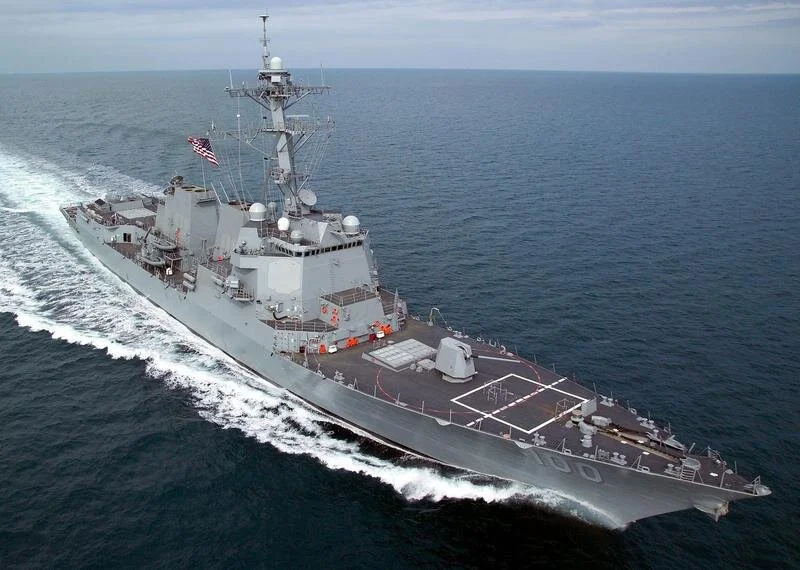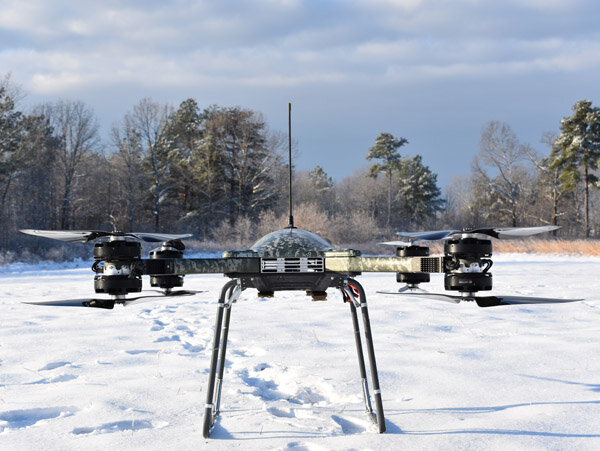“DRONE SWARMS”: UAPs or other actors?
REPORTS AND IMAGES of multiple “drone swarms” around a fleet of US naval vessels off the Californian coast in July 2019 have emerged in recent weeks, sparking off a debate regarding whether the objects were Chinese or Russian tech, aberrations in the camera used or something else entirely, one warranting a true UAP label. New details appear to be emerging regarding this incident each day, but it is still unclear what was being observed and recorded, due to the lack of details and an inability to hear testimony from witnesses onboard the vessels. The silence from the US Department of Defense is irritating to onlookers interested in the UAP issue, although understandable for those familiar with how previous encounters were officially dealt with. Rather than finding out just what occurred off southern California, we have to settle for the now-familiar “drip, drip, drip” release of details and simply ride out the inevitable speculation and ill-informed comments that inevitably appear in the absence of hard facts. Nature abhors a vacuum.
Of course, having few details to work with has not prevented some folks from already making up their minds as to the exact nature of the objects being filmed, whilst others take a more measured and pragmatic view, holding an opinion but refusing to take a firm position until more facts are known. At least one notable debunker has dismissed the whole episode by providing a possible explanation, even though it is still not entirely clear if the video that was released into the public domain by documentary maker Jeremy Corbell relates to the actual encounter in question. In spite of this lack of information, one thing appears to be clear from the deck logs obtained by FOIA requests from Dave Beaty and others who are doing excellent work in tracking down details which may provide more answers. Several objects labelled by watch-keeping personnel as “drones” were sighted in close proximity to US naval vessels on multiple occasions in July 2019. However, in the absence of further details, both the origin and purpose of these objects are unknown at present, at least to those existing outside the tight circle of decision makers in the US Department of Defense.
On the face of it, the fact that such items appear to be able to operate in the vicinity of US naval vessels should be alarming from both a national security and a UAP standpoint: both suggest an inability on the part of the US Navy to be able to do anything about these unwanted “snoopers”. However, a more rational view involves the ships’ locations and rules of engagement in force at the time, the latter dictating any likely response to an incursion into an exercise area.

The USS Kidd encountered a ‘drone swarm’ in July 2019. Pic via Wikimedia.
The July 2019 San Clemente Incident
Whilst I recognise there is some serious pushback on social media regarding The Drive’s article regarding the likelihood that the “drones” that were observed in the vicinity of the American vessels were indeed Chinese devices on some sort of intelligence-gathering mission, and possibly launched from a nearby ship, indulge me for a few moments whilst I run through the possibilities. Feel free to substitute “UAP” for “drones” at any point: the argument I am attempting to present is, I feel, equally as valid for each of these possible labels.
Three separate guided missile destroyers belonging to Destroyer Squadron 23 (DESRON 23 “The Little Beavers”) plus elements of Carrier Strike Group 9 (CSG-9) were involved in a series of encounters with multiple unidentified “drones” over several nights in mid-July 2019. Three of the ships identified so far include the Arleigh Burke-class vessels USS Russell (DDG-59), USS Paul Hamilton (DDG-60) and USS Kidd (DDG-100), which were engaged in an exercise around 50 miles west-southwest of San Clemente Island, off the coast of southern California. Over four different evenings that month, at least six objects, classified in the ships’ deck logs as “drones”, approached the vessels during the exercise in foggy or low visibility conditions. As would be expected, descriptions of the mysterious “snoopers” vary between the various vessels. According to the logs obtained under FOIA, the reports use the phrases “red lights”, “white lights”, “flashing red lights”, “UAV”, and “drone”, but all presumably refer to the same set of objects. Since the original reports emerged, further FOIA requests have expanded upon the list of ships involved in this incident. It now includes the Arleigh Burke-class USS Pinckney (DDG-91), the Ticonderoga-class guided missile cruiser USS Bunker Hill (CG-52), and the Independence-class littoral combat ship USS Omaha (LCS-12), the first two belonging to CSG-9.
The devices reportedly hovered over helicopter decks and maintained station off their port and starboard sides in a series of manoeuvres that were recorded by the Ships’ Nautical Or Otherwise Photographic Interpretation & Exploitation (SNOOPIE) teams. This was part of a concerted effort to obtain intelligence on the nature of these objects, and the vessels involved immediately switched off their radio and radar gear for emissions control (EMCON) purposes. The reason for this was twofold: 1) to prevent the “drones” from obtaining further details of the ships’ electronic emissions “signature”, which would be very useful to a potential adversary, and 2) to allow their own surveillance systems to work more effectively. Essentially, EMCOM would allow the destroyers to stop the “drones” learning more about them whilst at the same time gathering all available details about the intruders’ own electronic “signatures”. Whilst such measures suggest a terrestrial origin for the devices, this approach is standard procedure for an event of this nature. Even small details relating to the control systems or relaying of data obtained by these “drones” would prove very useful in determining their potential point of origin in any post-incident investigation.
Commentators who ask, “why didn’t the US Navy just shoot the drones down?” forget that the standard Rules of Engagement (ROE) in force at the time may not have allowed such an action to take place, at least without increased signs of hostility on the part of the objects that were witnessed.
To quote from the Standing Rules of Engagement/Standing Rules for the Use of Force for US Forces (13 June 2005).
Whatever it is, the way you tell your story online can make all the difference.“ROE provide a limit on operations and ensure that US actions do not trigger undesired escalation, i.e. forcing a potential opponent into a ‘self-defense’ response.”
In other words, the gloves don’t come off until there’s a much greater level of threat. Going into a situation where you are not entirely in control – or even in control at all, and with all guns blazing, does not seem like a sensible course of action, especially one which could lead to further problems. Without knowing what these objects were, and what they were capable of, opening up on them may have been the worst thing a ship’s captain could have done. Military drones can carry a variety of weapons and electronic warfare devices. Who knows what kind of missiles or “smart bombs” could have been released in any retaliatory action by the surviving “drones”? If they were “true” UAPs, what kind of strike would they be capable of unleashing in return after a hostile act? Better to take your finger off the “fire” button for the time being and see if a threat develops.
There’s also another good reason why the US Navy did not bring the “drones” down. If the SNOOPIE teams and others from the three vessels were trying to gain electronic intelligence from these devices, the last thing they would want would be to shoot them out of the sky. Think about it for a minute. There would have been no value in removing a potential source of information as to what they were and who sent them – if indeed they were, as some suspect, Chinese drones. The same would apply if anyone believed that these objects were “Tic Tacs”, or anywhere between these two extremes. Far better to collect emissions data which could be analysed and acted upon in a more rational manner. Of course, if these “drones” started endangering the vessels themselves, or the helicopters embarked on them, then that would be a different matter entirely. In such a case, the ROE would immediately change, and our news bulletins in July 2019 would have been filled with stories about how a potential threat was averted – or that we went to war with aliens.
Has this kind of thing happened again since July 2019? The US Navy aren’t telling – for the moment. However, it is inconceivable that further incidents are not occurring, given the details that have emerged regarding the Navy’s continuing encounters with strange objects since November 2004. News of these seem to suddenly explode on social media portals in a rush of initial info, speculation and arguments, often with little supporting information. That is not a criticism of those providing such details, merely an observation. In the case of the July 2019 incident, the true work is done by those in the background who are chasing after possible witnesses, filing FOIA requests and generally doing the legwork, essential tasks that don’t necessarily make the headlines, but which are key to bringing the facts out into the open.
Whether the objects witnessed over USS Kidd and her sister ships nearly two years ago were Chinese drones, devices built by another Earth-bound adversary or something else entirely is a question that may not be satisfactorily answered any time soon. The Chinese Communist Party are not about to hold their hands up and admit to flying drones over US warships unless there was some particular advantage to doing so. From their point of view, it would be beneficial to simply sit back and let the Americans think it was their technology. Rumours of hi-spec devices demonstrating giant leaps in performance and capabilities would be just as good as building the real thing. The Soviet Union practically bankrupted itself trying to match the American “Star Wars” anti-missile programme in the 1980s, even though it was never a practical proposition. Even the possibility of a threat can be just as damaging to an opponent as the device itself. Demonstrating an increased level of technology, one that appears oblivious to or scathing of your own defences, followed by complete silence on the incident, is another good way of unsettling your adversaries. Admitting responsibility confers a fact, one which provides a small measure of stability in an otherwise worrying situation, as capabilities become known, and counter-measures can be drafted. Far better to simply let your opponent tie themselves in knots wondering about what you are truly capable of.
If these objects were UAPs, then the threat is the same, and maybe even worse. Off-world or “ultra-terrestrial” device self-defence or attack capabilities would be simply incomprehensible until actually demonstrated. The sanest solution is therefore simply to watch and learn. It also shows restraint on behalf of those capable of unleashing deadly force. Science-fiction writers have often portrayed aliens treating “warlike” Earthlings with disdain. If this is ET, then far better to disprove this admittedly anthropomorphic view as soon as possible.
Drones and the Royal Navy
Currently, at least according to publicly-available sources, the Royal Navy’s Fleet Air Arm does not operate drones that demonstrate capabilities shown by the objects involved in the 2019 incident off southern California. 700X Naval Air Squadron has its own “Phantom flights” of deployable Puma UAVs, which are small surveillance drones capable of around 50 mph and an endurance of about two hours. 700X has embarked on the amphibious assault ship HMS Albion (L14). The Royal Marines have also trialled the use of Malloy T-150 quadcopters for intelligence, surveillance and reconnaissance duties on the battlefront, and the makers of this drone are currently working with the Royal Navy to develop a “heavy lift” UAV capable of transferring supplies between ships or from shore installations to vessels. The Navy also has its sights set on Unmanned Warrior, a project which, if successful, will bring a range of autonomous platforms into use, capable of diverse duties such as mine counter-measures to underwater survey.

The Malloy T-150 Quadcopter. ©malloyaeronautics.com
If any of the Royal Navy’s much smaller fleet of vessels have encountered similar “drone” incursions to those experienced by the US Navy in July 2019, then the Ministry of Defence’s (MOD) traditional tight-lipped approach will no doubt keep the details of any incidents hidden away for many years to come. Recent announcements by the MOD may however increase the likelihood of a similar event, especially if Chinese-built drones are responsible. The Royal Navy is due to deploy its new aircraft carrier, HMS Queen Elizabeth (R08), along with two destroyers and two frigates to the Far East and Pacific Ocean later this year. Also expected to join this deployment is the Arleigh Burke-class guided missile destroyer USS The Sullivans (DDG-68) and a Dutch combat vessel. Depending on the sensitivity of the areas visited, will a similar incident involving mysterious drones occur? Is the MOD aware of the July 2019 event and have assessments been made about a possible repeat of this event?
One can hope that if a similar occurrence does take place in the Far East or the Pacific Ocean, then the Royal Navy’s version of the American SNOOPIE teams will gather details of the encounter. However, if so, it may well be much more difficult to obtain this information given the different approach taken by the MOD in terms of disclosure. We will simply have to wait and see what happens.
